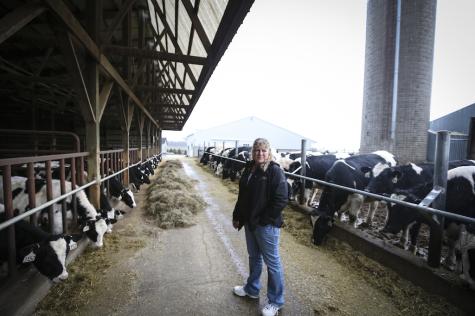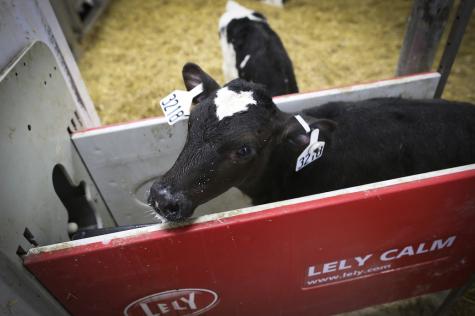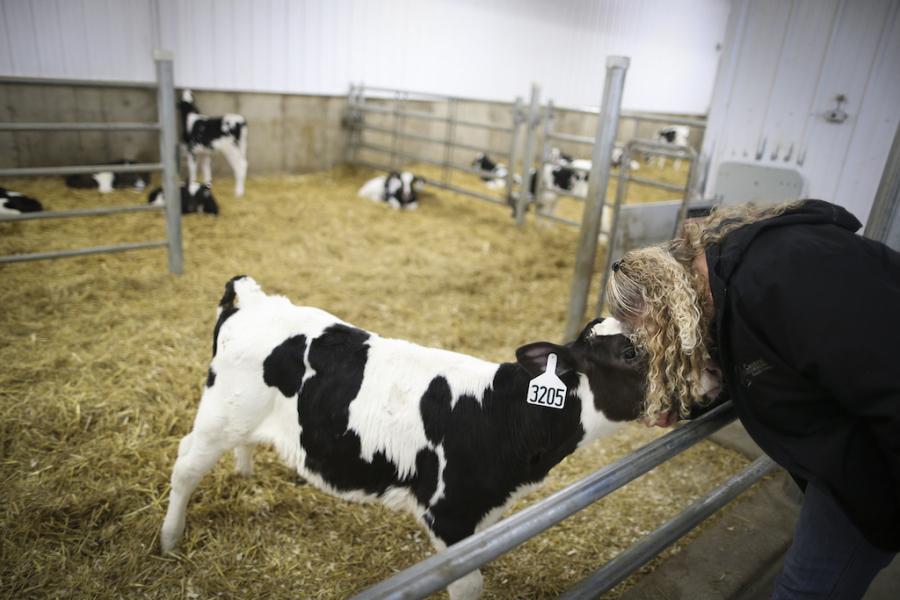High-Tech Feeders Free Dairy Farmers
Michele Rohe puts her face lovingly up to a calf at her dairy farm near Freeport, Minn. The farm’s open pens give heifer calves a chance to move around, feed when they want and interact with other calves and humans.
November 21, 2014
By Tom Meersman
FREEPORT, Minn. — The calves at Rohe Dairy don’t bawl when they’re hungry.
They live together in small groups in a tall, well-ventilated barn here, about 90 miles northwest of Minneapolis, and they eat whenever they please from an automated calf feeding machine.
The calf feeders, outfitted with scanners and sophisticated engineering, are the latest high-tech addition to dairies, which have also begun to invest in robotic milkers for their cows.
“Our conclusion is that automated calf feeders are here to stay, and they seem to be drawing more and more interest,” said Tom Earleywine, director of nutritional services for Land O’Lakes Animal Milk Products, which has done research on the technology.
Increasingly sophisticated equipment is bringing dramatic change to the lives of dairy farmers throughout the Midwest. Researchers at Iowa State University have calculated that the feeders can reduce labor costs by more than 40 percent, make farmers’ schedules more flexible and allow more time for producers to monitor and manage calf health.
At Rohe’s barn, 31 calves are separated into three roomy pens, according to their age. On a recent morning, some lay contentedly in the deep straw and others cavorted in playful running and jumping. As Michele Rohe opened a gate, a handful of them pushed forward as she began to stroke their heads and necks.
“They’re just like kids,” she said. “You’ll have a couple that will head butt each other a little, or at least push back and forth. And then you’ll see others grouped up with their heads affectionately right on top of one another’s body.”

OLD SYSTEM: ISOLATED STALLS
The scene in the barn was starkly different from the traditional way of raising calves.
That method typically isolates calves by housing them in individual hutches, often outdoors, with little room to move and no opportunity to interact with other calves. They are usually fed twice a day and remain in the light-colored structures for about eight weeks until they’re weaned.
That system worked well for generations, said Marcia Endres, a University of Minnesota animal science professor and dairy specialist, but feeding calves individually is labor-intensive and time-consuming. Automatic feeders give farmers more flexibility with their schedules, she said, and they allow calves to socialize, move around, and feed in a more natural way.
But with the advantages come additional risks: calves growing up together may be more vulnerable to disease, Endres said.
“It’s like taking the kids to day care,” she said. “Now they’re mixed with other calves and they can get more disease, so we have to be on top of it and play close attention.”
Endres and a team of researchers are studying 38 farms with automated calf feeders in Minnesota, Wisconsin and Iowa, and have collected health and feeding data on more than 10,000 calves with the goal of developing best management practices for the new technology.
In Rohe’s barn, the feeding system works by customizing the amount and concentration of powdered “milk replacer” formula to each calf’s needs. As a calf enters a small stall and approaches a palm-sized flexible nipple, a scanner instantly reads identification tags on the calf’s ears, blends the formula with warm water in the amount and concentration prescribed for that calf, and dispenses it through tubes to the nipple.
Feedings for different calves are timed at different intervals, usually a few hours apart, and the feeder will not activate if a calf returns too soon. Amounts of food increase from about 5.5 to 7.5 liters a day as the calves grow, Rohe said, and then phase out completely as the oldest calves transition to solid feed and water and are weaned at 48 days.
$100,000 NEW BARN
Rohe’s husband and his two brothers own and operate the 250-cow dairy, she said, and they installed the automated calf feeder in August, 2012. They paid about $15,000 for the feeder and software, she said, and invested about $100,000 to add the calf barn and ventilation system to an existing building.
On a computer screen Rohe can view when and how much each calf has consumed, how often each has returned to the nipple, and even the speed at which they fed. A red bar will show up on the screen whenever a calf has not eaten, a sign that it may need to be reminded of where to find the nipple, or checked for sickness.
Rohe monitors the feeding process at least a couple times each day when she visits the barn, and she can call up real-time information with an app on her cellphone at any time of day or night. A surveillance camera in the barn also provides images that she can access on her phone to check for problems, such as whether calves are grouping up at the feeder — a possible sign that it’s plugged or somehow malfunctioning.

MORE FEEDING, LESS LABOR
Earleywine said automated calf feeders at first did little except mix the milk replacement formula that calves need. In recent years the machines have become far more sophisticated, he said, and Land O’Lakes has been using them as a research tool, currently with about 300 calves.
“The thing we love about them is that they give you an opportunity to get more frequent meals in the calf and obviously as a result you can provide a higher plane of nutrition and have the calf grow better,” Earleywine said.
High-quality food provided individually in the traditional way produces equally healthy calves, he said, but the labor of manually feeding calves twice a day is significant. “In the wintertime, calf hutches can be brutal,” he said.
The machines also allow producers more time to become calf managers, not just feeders, Earleywine said, with more flexibility in their daily schedules.
Minnesota has more than 4,000 dairies, and Earleywine estimated that 150 to 200 of them are now using about 400 automated feeders. He said the pace has picked up significantly in recent years.
But he cautioned that some machines are basic, and don’t have automatic cleaning devices or sophisticated software.
Endres at the university agreed that cleanliness cannot be emphasized enough, especially since calves with developing immune systems are vulnerable to disease. “Even though it’s an automated system, some parts of it still have to be cleaned manually by the producers, and not everybody (in our study) was doing that as well,” she said.
Rohe said that 431 calves, including the most recent born last week, have used her farm’s automated system during the past two years, and she’s pleased with the results.
‘BETTER HEALTH, BETTER GIRTH’
“They have better weight gain, better health and a better girth about them,” she said. “Before they’d have a little indent on their sides but now they’re nicely formed and filled out animals.”
And Rohe said her calves raised with playmates seem to be less skittish and easier to handle as they mature.
The feeding machine has also completely changed the dynamic between her and the calves, Rohe said, compared to the previous system of feeding calves individually in their hutches.
“If you were to walk out there during the middle of the day, they’d all get up and they’d all start bellering because to them you’re food,” she said. “Now in the barn, since they’re on the feeding system and they’re satisfied throughout the day, they’re just happy.”
©2014 Star Tribune (Minneapolis)
Visit the Star Tribune (Minneapolis) at www.startribune.com
Distributed by Tribune Content Agency, LLC
















